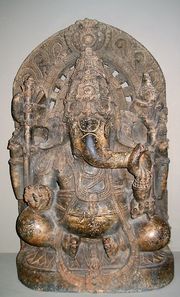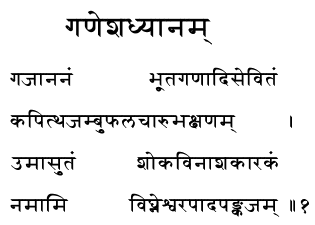Ganpatiji
Ganesha“Vinayaka” redirects here. For other uses, see Vinayaka (disambiguation).”Ganapati” redirects here. For Hindu Vedic Deity and God of planet Jupiter, see Brihaspati.For other uses, see Ganesha (disambiguation).
Ganesha (Sanskrit: गणेश; IAST: Gaṇeśa; listen (help·info)), also spelled Ganesaor Ganeshand also known as Ganapati,Vinayaka, and Pillaiyar, is one of the best-known and most widely worshipped deities in the Hindu pantheon.[5] His image is found throughout India.[6] Hindu sects worship him regardless of affiliations.[7] Devotion to Ganesha is widely diffused and extends to Jains, Buddhists, and beyond India.[8] Although he is known by many other attributes, Ganesha’s elephant head makes him easy to identify.[9] Ganesha is widely revered as the Remover of Obstacles[10]and more generally as Lord of Beginnings and Lord of Obstacles (Vighnesha, Vighneshvara),[11]patron of arts and sciences, and the deva of intellect and wisdom.[12] He is honoured at the beginning of rituals and ceremonies and invoked as Patron of Letters during writing sessions.[13] Several texts relatemythological anecdotes associated with his birth and exploits and explain his distinct iconography. Ganesha emerged as a distinct deity in clearly recognizable form in the 4th and 5th centuriesCE, during the Gupta Period, although he inherited traits from Vedic and pre-Vedic precursors.[14] His popularity rose quickly, and he was formally included among the five primary deities of Smartism (a Hindu denomination) in the 9th century. A sect of devotees called theGanapatya, (Sanskrit: गाणपत्य;gāṇapatya), who identified Ganesha as the supreme deity, arose during this period.[15] The principal scriptures dedicated to Ganesha are the Ganesha Purana, the Mudgala Purana, and the Ganapati Atharvashirsa. Etymology and other names
Ganesha as ‘Shri Mayureshwar’ with consorts Buddhi and Siddhi, Morgaon (the central shrine for the regionalaṣṭavināyakacomplex)[16]Ganesha has many other titles and epithets, including Ganapati and Vigneshvara. The Hindu title of respect Shri (Sanskrit: श्री; śrī, also spelled Sri or Shree) is often added before his name. One popular way Ganesha is worshipped is by chanting a Ganesha Sahasranama, a litany of “a thousand names of Ganesha”. Each name in the sahasranama conveys a different meaning and symbolises a different aspect of Ganesha. At least two different versions of the Ganesha Sahasranama exist; one version is drawn from the Ganesha Purana, a Hindu scripture venerating Ganesha.[17] The name Ganesha is a Sanskrit compound, joining the words gana(Sanskrit: गण; gaṇa), meaning a group, multitude, or categorical system and isha(Sanskrit: ईश; īśa), meaning lord or master.[18] The word gaņa when associated with Ganesha is often taken to refer to the gaņas, a troop of semi-divine beings that form part of the retinue of Shiva (IAST: Śiva).[19] The term more generally means a category, class, community, association, or corporation.[20] Some commentators interpret the name “Lord of the Gaņas” to mean “Lord of Hosts” or “Lord of created categories”, such as the elements.[21] Ganapati(Sanskrit: गणपति; gaṇapati), a synonym forGanesha, is a compound composed of gaṇa, meaning “group”, and pati, meaning “ruler” or “lord”.[20]The Amarakosha,[22] an early Sanskrit lexicon, lists eight synonyms ofGanesha: Vinayaka, Vighnarāja (equivalent to Vignesha), Dvaimātura (one who has two mothers),[23] Gaṇādhipa (equivalent to Ganapati and Ganesha), Ekadanta (one who has one tusk), Heramba, Lambodara (one who has a pot belly, or, literally, one who has a hanging belly), and Gajanana (IAST: gajānana) ; having the face of an elephant).[24] Vinayaka (Sanskrit: विनायक; vināyaka) is a common name for Ganesha that appears in thePurāṇas and in Buddhist Tantras.[25] This name is reflected in the naming of the eight famous Ganesha temples in Maharashtra known as the Ashtavinayak (aṣṭavināyaka).[26]The namesVignesha(Sanskrit: विघ्नेश; vighneśa) and Vigneshvara (Sanskrit: विघ्नेश्वर; vighneśvara) (Lord of Obstacles)[11] refers to his primary function in Hindu mythology as the creator and remover of obstacles (vighna).[27] A prominent name for Ganesha in the Tamil language is Pille or Pillaiyar (Little Child).[28] A. K. Narain differentiates these terms by saying that pille means a “child” while pillaiyar means a “noble child”. He adds that the words pallu, pella, and pell in the Dravidian family of languages signify “tooth or tusk of an elephant”, but more generally “elephant”.[29] Anita Raina Thapan notes that the root word pille in the name Pillaiyar might have originally meant “the young of the elephant”, because the Pali word pillaka means “a young elephant”.[30] Iconography
See also: SritattvanidhiThis statue of Ganesha was created in the Mysore DistrictofKarnataka in the 13th century.Ganesha is a popular figure in Indian art.[31] Unlike those of some deities, representations of Ganesha show wide variations and distinct patterns changing over time.[32] He may be portrayed standing, dancing, heroically taking action against demons, playing with his family as a boy, sitting down, or engaging in a range of contemporary situations. Images of Ganesha first appeared in Sri Lanka at least as early as the 2nd century CE. The earliest known image occurs at the Kantaka Cetiya in Mihintale, which is dated to earlier than the 1st century BC. The figure is a one-tusked Gana (dwarf) attended by other ganas, who hold the various attributes of the deity.[33] Ganesha images were prevalent in many parts of India by the 6th century.[34]The figure shown to the right is typical of Ganesha statuary from 900–1200, after Ganesha had been well-established as an independent deity with his own sect. This example features some of Ganesha’s common iconographic elements. A virtually identical statue has been dated between 973–1200 by Paul Martin-Dubost,[35] and another similar statue is dated c. 12th century by Pratapaditya Pal.[36] Ganesha has the head of an elephant and a big belly. This statue has four arms, which is common in depictions of Ganesha. He holds his own broken tusk in his lower-right hand and holds a delicacy, which he samples with his trunk, in his lower-left hand. The motif of Ganesha turning his trunk sharply to his left to taste a sweet in his lower-left hand is a particularly archaic feature.[37] A more primitive statue in one of the Ellora Caveswith this general form has been dated to the 7th century.[38] Details of the other hands are difficult to make out on the statue shown. In the standard configuration, Ganesha typically holds an axe or a goad in one upper arm and a noose in the other upper arm. The influence of this old constellation of iconographic elements can still be seen in contemporary representations of Ganesha. In one modern form, the only variation from these old elements is that the lower-right hand does not hold the broken tusk but rather is turned toward the viewer in a gesture of protection or fearlessness (abhaya mudra).[39] The same combination of four arms and attributes occurs in statues of Ganesha dancing, which is a very popular theme.[40] Common attributesA typical four-armed form. Miniature of Nurpur school (circa 1810).[41]Ganesha has been represented with the head of an elephant since the early stages of his appearance in Indian art.[42] Puranic myths provide many explanations for how he got his elephant head.[43] One of his popular forms, Heramba-Ganapati, has five elephant heads, and other less-common variations in the number of heads are known.[44] While some texts say that Ganesha was born with an elephant head, in most stories he acquires the head later.[45] The most recurrent motif in these stories is that Ganesha was born with a human head and body and that Shiva beheaded him when Ganesha came between Shiva and Parvati. Shiva then replaced Ganesha’s original head with that of an elephant.[46] Details of the battle and where the replacement head came from vary according to different sources.[47] In another story, when Ganesha was born, his mother, Parvati, showed off her new baby to the other gods. Unfortunately, the god Shani (Saturn), who is said to have the evil eye, looked at him, causing the baby’s head to be burned to ashes. The god Vishnu came to the rescue and replaced the missing head with that of an elephant.[48] Another story says that Ganesha was created directly by Shiva’s laughter. Because Shiva considered Ganesha too alluring, he gave him the head of an elephant and a protruding belly.[49] Ganesha’s earliest name was Ekadanta (One Tusk), referring to his single whole tusk, the other having been broken off.[50] Some of the earliest images of Ganesha show him holding his broken tusk.[51] The importance of this distinctive feature is reflected in theMudgala Purana, which states that the name of Ganesha’s second incarnation is Ekadanta.[52] Ganesha’s protruding belly appears as a distinctive attribute in his earliest statuary, which dates to the Gupta period (fourth to sixth centuries).[53] This feature is so important that, according to the Mudgala Purana, two different incarnations of Ganesha use names based on it: Lambodara (Pot Belly, or, literally, Hanging Belly) and Mahodara (Great Belly).[54] Both names are Sanskrit compounds describing his belly (Sanskrit: udara).[55] The Brahmanda Purana says that Ganesha has the name Lambodara because all the universes (i.e., cosmic eggs; IAST: brahmāṇḍas) of the past, present, and future are present in him.[56] The number of Ganesha’s arms varies; his best-known forms have between two and sixteen arms.[57] Many depictions of Ganesha feature four arms, which is mentioned in Puranic sources and codified as a standard form in some iconographic texts.[58] His earliest images had two arms.[59] Forms with 14 and 20 arms appeared in central India during the 9th and 10th centuries.[60] The serpent is a common feature in Ganesha iconography and appears in many forms.[61] According to the Ganesha Purana, Ganesha wrapped the serpent Vāsuki around his neck.[62] Other depictions of snakes include use as a sacred thread (IAST: yajñyopavīta)[63] wrapped around the stomach as a belt, held in a hand, coiled at the ankles, or as a throne. Upon Ganesha’s forehead there may be a third eye or theShaivite sectarian mark (Sanskrit:tilaka), which consists of three horizontal lines.[64] TheGanesha Puranaprescribes a tilaka mark as well as a crescent moon on the forehead.[65] A distinct form of Ganesha called Bhalachandra (IAST: bhālacandra; “Moon on the Forehead”) includes that iconographic element. Specific colors are associated with certain forms.[66] Many examples of color associations with specific meditation forms are prescribed in theSritattvanidhi, a treatise on Hindu iconography. For example, white is associated with his representations as Heramba-Ganapati and Rina-Mochana-Ganapati (Ganapati Who Releases from Bondage).[67] Ekadanta-Ganapatiis visualized as blue during meditation on that form.[68] Vahanas
The earliest Ganesha images are without a vahana (mount).[69] Of the eight incarnations of Ganesha described in the Mudgala Purana, Ganesha has a mouse in five of them, uses a lion in his incarnation as Vakratunda, a peacock in his incarnation of Vikata, and Shesha, the divine serpent, in his incarnation as Vighnaraja.[70] Of the four incarnations of Ganesha listed in theGanesha Purana, Mohotkata has a lion, Mayūreśvara has a peacock, Dhumraketu has a horse, and Gajanana has a rat.[71] Jain depictions of Ganesha show his vahana variously as a mouse, elephant, tortoise, ram, or peacock.[72] Ganesha dancing on his mouse, 11th century, Bengal,musée d’art asiatique de Berlin.Ganesha is often shown riding on or attended by a mouse or rat.[73] Martin-Dubost says that the rat began to appear as the principal vehicle in sculptures of Ganesha in central and western India during the 7th century; the rat was always placed close to his feet.[74]The mouse as a mount first appears in written sources in the Matsya Purana and later in the Brahmananda Purana andGanesha Purana, where Ganesha uses it as his vehicle only in his last incarnation.[75] TheGanapati Atharvashirsa includes a meditation verse on Ganesha that describes the mouse appearing on his flag.[76] The names Mūṣakavāhana (mouse-mount) and Ākhuketana (rat-banner) appear in the Ganesha Sahasranama.[77] The mouse is interpreted in several ways. According to Grimes, “Many, if not most of those who interpret Gaṇapati’s mouse, do so negatively; it symbolizes tamoguṇaas well as desire”.[78]Along these lines, Michael Wilcockson says it symbolizes those who wish to overcome desires and be less selfish.[79] Krishan notes that the rat is destructive and a menace to crops. The Sanskrit wordmūṣaka (mouse) is derived from the root mūṣ (stealing, robbing). It was essential to subdue the rat as a destructive pest, a type ofvighna (impediment) that needed to be overcome. According to this theory, showing Ganesha as master of the rat demonstrates his function as Vigneshvara (Lord of Obstacles) and gives evidence of his possible role as a folkgrāmata-devatā (village deity) who later rose to greater prominence.[80]Martin-Dubost notes a view that the rat is a symbol suggesting that Ganesha, like the rat, penetrates even the most secret places.[81] AssociationsObstacles
An elaborate idol of Ganesha at the Kudroli Bhagavathi temple in Mangalore, India. Ganesha is widely worshiped across India as the remover of obstacles.Ganesha is Vighneshvara or Vighnaraja, the Lord of Obstacles, both of a material and spiritual order.[82] He is popularly worshipped as a remover of obstacles, though traditionally he also places obstacles in the path of those who need to be checked. Paul Courtright says that “his task in the divine scheme of things, his dharma, is to place and remove obstacles. It is his particular territory, the reason for his creation.”[83] Krishan notes that some of Ganesha’s names reflect shadings of multiple roles that have evolved over time.[27] Dhavalikar ascribes the quick ascension of Ganesha in the Hindu pantheon, and the emergence of the Ganapatyas, to this shift in emphasis fromvighnakartā (obstacle-creator) to vighnahartā (obstacle-averter).[84]However, both functions continue to be vital to his character, as Robert Brown explains, “even after the Purāṇic Gaṇeśa is well-defined, in art Gaṇeśaremained predominantly important for his dual role as creator and remover of obstacles, thus having both a negative and a positive aspect”.[85] BuddhiGanesha is considered to be the Lord of letters and learning.[86] In Sanskrit, the word buddhi is a feminine noun that is variously translated as intelligence, wisdom, or intellect.[87] The concept of buddhi is closely associated with the personality of Ganesha, especially in the Puranic period, when many stories stress his cleverness and love of intelligence. One of Ganesha’s names in theGanesha Purana and the Ganesha Sahasranama is Buddhipriya.[88] This name also appears in a list of 21 names at the end of theGanesha Sahasranama that Ganesha says are especially important.[89] The word priya can mean “fond of”, and in a marital context it can mean “lover” or “husband”,[90] so the name may mean either “Fond of Intelligence” or “Buddhi’s Husband”.[91] AumGanesha is identified with the Hindu mantra Aum (ॐ, also called Om). The term oṃkārasvarūpa(Aum is his form), when identified with Ganesha, refers to the notion that he personifies the primal sound.[92] The Ganapati Atharvashirsaattests to this association. Chinmayananda translates the relevant passage as follows:
Ganesha (Devanagari) Aum jewelSome devotees see similarities between the shape of Ganesha’s body in iconography and the shape of Aum in the Devanāgarī andTamil scripts.[94] First chakraAccording to Kundalini yoga, Ganesha resides in the first chakra, called Muladhara (mūlādhāra).Mula means “original, main”; adharameans “base, foundation”. The muladhara chakra is the principle on which the manifestation or outward expansion of primordial Divine Force rests.[95]This association is also attested to in the Ganapati Atharvashirsa. Courtright translates this passage as follows: “[O Ganesha,] You continually dwell in the sacral plexus at the base of the spine [mūlādhāra cakra].”[96] Thus, Ganesha has a permanent abode in every being at the Muladhara.[97] Ganesha holds, supports and guides all other chakras, thereby “governing the forces that propel the wheel of life”.[95] Family and consortsFor more details on this topic, see Consorts of Ganesha
.Shiva and Pārvatī giving a bath to Gaṇeśa. Kangra miniature, 18th century. Allahbad Museum, New Delhi.[98] Though Ganesha is popularly held to be the son of Shiva and Parvati, the Puranic myths disagree about his birth.[99] He may have been created by Shiva,[100] or by Parvati,[101] or by Shiva and Parvati,[102] or appeared mysteriously and was discovered by Shiva and Parvati.[103] The family includes his brother Skanda, who is also called Karttikeya, Murugan, and other names.[104] Regional differences dictate the order of their births. In northern India, Skanda is generally said to be the elder, while in the south, Ganesha is considered the first born.[105]Skanda was an important martial deity from about 500 BCE to about 600 CE, when worship of him declined significantly in northern India. As Skanda fell, Ganesha rose. Several stories tell of sibling rivalry between the brothers[106] and may reflect sectarian tensions.[107] Ganesha’s marital status, the subject of considerable scholarly review, varies widely in mythological stories.[108] One pattern of myths identifies Ganesha as an unmarriedbrahmacārin.[109] This view is common in southern India and parts of northern India.[110]Another pattern associates him with the concepts of Buddhi(intellect), Siddhi (spiritual power), andRiddhi (prosperity); these qualities are sometimes personified as goddesses, said to be Ganesha’s wives.[111] He also may be shown with a single consort or a nameless servant (Sanskrit: daşi).[112] Another pattern connects Ganesha with the goddess of culture and the arts, Sarasvati orŚarda (particularly in Maharashtra).[113] He is also associated with the goddess of luck and prosperity, Lakshmi.[114] Another pattern, mainly prevalent in the Bengalregion, links Ganesha with the banana tree, Kala Bo.[115] The Shiva Purana says that Ganesha had two sons: Kşema (prosperity) and Lābha (profit). In northern Indian variants of this story, the sons are often said to be Śubha (auspiciouness) andLābha.[116] The 1975 Hindi film Jai Santoshi Maa shows Ganesha married to Riddhi and Siddhi and having a daughter named Santoshi Ma, the goddess of satisfaction. This story has no Puranic basis, but Anita Raina Thapan and Lawrence Cohen cite Santoshi Ma’s cult as evidence of Ganesha’s continuing evolution as a popular deity.[117] Worship and festivalsCelebrations of Ganesh by the Indian and Sri Lankan Tamilcommunity in Paris,France.Ganesha is worshipped on many religious and secular occasions; especially at the beginning of ventures such as buying a vehicle or starting a business.[118] K.N. Somayaji says, “there can hardly be a [Hindu] home [in India] which does not house an idol of Ganapati. [..] Ganapati, being the most popular deity in India, is worshipped by almost all castes and in all parts of the country”.[119]Devotees believe that if Ganesha is propitiated, he grants success, prosperity and protection against adversity.[120] Ganesha is a non-sectarian deity, and Hindus of all denominations invoke him at the beginning of prayers, important undertakings, and religious ceremonies.[121]Dancers and musicians, particularly in southern India, begin performances of arts such as theBharatnatyam dance with a prayer to Ganesha.[122] Mantras such as Om Shri Gaṇeshāya Namah (Om, salutation to the Illustrious Ganesha) are often used. One of the most famous mantras associated with Ganesha is Om Gaṃ Ganapataye Namah (Om, Gaṃ, Salutation to the Lord of Hosts).[123] Devotees offer Ganesha sweets such as modaka and small sweet balls (laddus).[124]He is often shown carrying a bowl of sweets, called a modakapātra.[125] Because of his identification with the color red, he is often worshipped with red sandalwood paste (raktacandana)[126] or red flowers. Dūrvā grass (Cynodon dactylon) and other materials are also used in his worship.[127] Festivals associated with Ganesh are “the Vināyaka caturthī (Ganesh Chaturthi) in theśuklapakṣa (the fourth day of the waxing moon) in the month of bhādrapada(August/September) and the Gaṇeśa jayanti (Gaṇeśa’s birthday) celebrated on the cathurthī of thekṛṣṇapakṣa (fourth day of the waning moon) in the month of māgha (January/February).”[128] Ganesh ChaturthiMain article: Ganesh Chaturthi
The visarjan ceremony of Lord Ganesh during the Chaturthi festival in Hyderabad, India An annual festival honours Ganesha for ten days, starting on Ganesh Chaturthi, which typically falls in late August or early September.[129] The festival culminates on the day of Ananta Chaturdashi, when images (murtis) of Ganesha are immersed in the most convenient body of water.[130] In 1893, Lokmanya Tilak transformed this annual Ganesha festival from private family celebrations into a grand public event.[131] He did so “to bridge the gap between the Brahminsand the non-Brahmins and find an appropriate context in which to build a new grassroots unity between them” in his nationalistic strivings against the British inMaharashtra.[132] Because of Ganesha’s wide appeal as “the god for Everyman”, Tilak chose him as a rallying point for Indian protest against British rule.[133] Tilak was the first to install large public images of Ganesha in pavilions, and he established the practice of submerging all the public images on the tenth day.[134] Today, Hindus across India celebrate the Ganapati festival with great fervour, though it is most popular in the state of Maharashtra.[135][136] The festival also assumes huge proportions in Mumbai and in the surrounding belt of Ashtavinayaka temples. TemplesFurther information: List of Ganapati temples and AshtavinayakIn Hindu temples, Ganesha is depicted in various ways: as an acolyte or subordinate deity (pãrśva-devatã); as a deity related to the principal deity (parivāra-devatã); or as the principal deity of the temple (pradhāna), treated similarly as the highest gods of the Hindu pantheon.[137]As the god of transitions, he is placed at the doorway of many Hindu temples to keep out the unworthy, which is analogous to his role as Parvati’s doorkeeper.[138] In addition, several shrines are dedicated to Ganesha himself, of which the Ashtavinayak (Sanskrit: अष्टविनायक;aṣṭavināyaka; lit. “eight Ganesha (shrines)”) in Maharashtra are particularly well known. Located within a 100-kilometer radius of the city of Pune, each of these eight shrines celebrates a particular form of Ganapati, complete with its own lore and legend; together they “form amandala, demarking the sacred cosmos of Ganesha”.[139]
A statue of Ganesha carved in woodThere are many other important Ganesha temples at the following locations: Wai in Maharashtra; Ujjain in Madhya Pradesh;Jodhpur, Nagaur and Raipur (Pali) in Rajasthan; Baidyanath in Bihar; Baroda, Dholaka, and Valsad in Gujarat and Dhundiraj Temple in Varanasi,Uttar Pradesh. Prominent Ganesha temples in southern India include the following: : the Jambukeśvara Temple (Ucchi pillaiyar kottai) at Tiruchirapalli; at Rameshvaram and Suchindram;Karpaka Vinayakar Temple in TamilNadu; Hampi, Kasargod, andIdagunji in Karnataka; andBhadrachalam in Andhra Pradesh.[140][141] T. A. Gopinatha notes, “Every village however small has its own image of Vighneśvara(Vigneshvara) with or without a temple to house it in. At entrances of villages and forts, belowpīpaḹa trees […], in a niche […] in temples of Viṣṇu(Vishnu) as well as Śiva (Shiva) and also in separate shrines specially constructed in Śiva temples […]; the figure of Vighneśvara is invariably seen.”[142] Ganesha temples have also been built outside of India, including southeast Asia, Nepal,[143]and in several western countries.[144] Rise to prominenceFirst appearanceGanesha appeared in his classic form as a clearly-recognizable deity with well-defined iconographic attributes in the early 4th to 5th centuries.[145] Shanti Lal Nagar says that the earliest known iconic image of Ganesha is in the niche of the Shiva temple at Bhumra, which has been dated to the Gupta period.[146] His independent cult appeared by about the 10th century.[145] Narain summarizes the controversy between devotees and academics regarding the development of Ganesha as follows:
Possible influencesCourtright reviews various speculative theories about the early history of Ganesha, including supposed tribal traditions and animal cults, and dismisses all of them in this way:
Thapan’s book on the development of Ganesha devotes a chapter to speculations about the role elephants had in early India but concludes that, “although by the second century AD the elephant-headed yakṣa form exists it cannot be presumed to representGaṇapati-Vināyaka. There is no evidence of a deity by this name having an elephant or elephant-headed form at this early stage.Gaṇapati-Vināyaka had yet to make his debut.”[149] One theory of the origin of Ganesha is that he gradually came to prominence in connection with the four Vinayakas (Vināyakas).[150]In Hindu mythology, the Vināyakas were a group of four troublesome demons who created obstacles and difficulties[151] but who were easily propitiated.[152] The name Vināyaka is a common name for Ganesha both in the Purāṇas and in Buddhist Tantras.[25]Krishan is one of the academics who accepts this view, stating flatly of Ganesha, “He is a non-vedic god. His origin is to be traced to the four Vināyakas, evil spirits, of the Mānavagŗhyasūtra (7th–4th century BCE) who cause various types of evil and suffering”.[153]Depictions of elephant-headed human figures, which some identify with Ganesha, appear inIndian art and coinage as early as the 2nd century.[154] The elephant-headed Ganesha as lord of the Ganas was known to the people of Sri Lanka in the early pre-Christian era.[33] Vedic and epic literatureFifth century marble Ganesha found at Gardez, Afghanistan, now at Dargah Pir Rattan Nath, Kabul. The inscription says that this “great and beautiful image of Mahāvināyaka” was consecrated by the Shahi King Khingala.[155] This content has an uncertain copyright status and is pending deletion. You can comment on its removal.The title “Leader of the group” (Sanskrit: gaṇapati) occurs twice in the Rig Veda, but in neither case does it refer to the modern Ganesha. The term appears in RV 2.23.1 as a title forBrahmanaspati, according to commentators.[156] While this verse doubtless refers to Brahmanaspati, it was later adopted for worship of Ganesha and is still used today.[157] In rejecting any claim that this passage is evidence of Ganesha in the Rig Veda, Ludo Rocher says that it “clearly refers to Bṛhaspati—who is the deity of the hymn—and Bṛhaspati only”.[158]Equally clearly, the second passage (RV 10.112.9) refers to Indra,[159] who is given the epithet ‘gaṇapati’, translated “Lord of the companies (of the Maruts).”[160] However, Rocher notes that the more recent Ganapatya literature often quotes the Rigvedic verses to give Vedic respectability to Ganesha .[161] Two verses in texts belonging to Black Yajurveda, Maitrāyaṇīya Saṃhitā (2.9.1)[162]and Taittirīya Āraṇyaka (10.1),[163] appeal to a deity as “the tusked one” (Dantiḥ), “elephant-faced” (Hastimukha), and “with a curved trunk” (Vakratuņḍa). These names are suggestive of Ganesha, and the 14th century commentator Sayana explicitly establishes this identification.[164] The description of Dantin, possessing a twisted trunk (vakratuṇḍa) and holding a corn-sheaf, a sugar cane, and a club,[165] is so characteristic of the Puranic Ganapati that Heras says “we cannot resist to accept his full identification with this Vedic Dantin”.[166]However, Krishan considers these hymns to be post-Vedic additions.[167] Thapan reports that these passages are “generally considered to have been interpolated”. Dhavalikar says, “the references to the elephant-headed deity in the Maitrāyaṇī Saṃhitā have been proven to be very late interpolations, and thus are not very helpful for determining the early formation of the deity”.[168] Ganesha does not appear in Indian epic literature that is dated to the Vedic period. A late interpolation to the epic poemMahabharata says that the sage Vyasa (Vyāsa) asked Ganesha to serve as his scribe to transcribe the poem as he dictated it to him. Ganesha agreed but only on condition that Vyasa recite the poem uninterrupted, that is, without pausing. The sage agreed, but found that to get any rest he needed to recite very complex passages so Ganesha would have to ask for clarifications. The story is not accepted as part of the original text by the editors of the critical edition of the Mahabharata,[169] in which the twenty-line story is relegated to a footnote in an appendix.[170] The story of Ganesha acting as the scribe occurs in 37 of the 59 manuscripts consulted during preparation of the critical edition.[171] Ganesha’s association with mental agility and learning is one reason he is shown as scribe for Vyāsa’s dictation of theMahabharata in this interpolation.[172] Richard L. Brown dates the story to the 8th century, and Moriz Winternitz concludes that it was known as early as c. 900, but it was not added to theMahabharata some 150 years later. Winternitz also notes that a distinctive feature in South Indian manuscripts of the Mahabharata is their omission of this Ganesha legend.[173] The termvināyaka is found in some recensions of the Śāntiparva and Anuśāsanaparva that are regarded as interpolations.[174] A reference to Vighnakartṛīṇām (“Creator of Obstacles”) in Vanaparva is also believed to be an interpolation and does not appear in the critical edition.[175] Puranic periodStories about Ganesha often occur in the Puranic corpus. Brown notes while the Puranas “defy precise chronological ordering”, the more detailed narratives of Ganesha’s life are in the late texts, c. 600–1300.[176] Yuvraj Krishan says that the Puranic myths about the birth of Ganesha and how he acquired an elephant’s head are in the later Puranas, which were composed from c. 600 onwards. He elaborates on the matter to say that references to Ganesha in the earlier Puranas, such as the Vayu and Brahmanda Puranas, are later interpolations made during the 7th to 10th centuries.[177] In his survey of Ganesha’s rise to prominence in Sanskrit literature, Ludo Rocher notes that:
Ganesha’s rise to prominence was codified in the 9th century, when he was formally included as one of the five primary deities ofSmartism. The 9th century philosopher Śaṅkarācāryapopularized the “worship of the five forms” (pañcāyatana pūjā) system among orthodox Brahmins of the Smarta tradition.[179] This worship practice invokes the five deities Ganesha, Vishnu, Shiva, Devī, andSūrya.[180] Śaṅkarācārya instituted the tradition primarily to unite the principal deities of these five major sects on an equal status. This formalized the role of Ganesha as a complementary deity. ScripturesFurther information: Ganesha Purana, Mudgala Purana and Ganapati Atharvashirsa
Statue of Ganesha with a flower Once Ganesha was accepted as one of the five principal deities of Brahmanism, some Brahmins(brāhmaṇas) chose to worship Ganesha as their principal deity. They developed the Ganapatyatradition, as seen in the Ganesha Purana and the Mudgala Purana.[181] The date of composition for the Ganesha Purana and the Mudgala Purana—and their dating relative to one another—has sparked academic debate. Both works were developed over time and contain age-layered strata. Anita Thapan reviews comments about dating and provides her own judgement. “It seems likely that the core of the Ganesha Purana appeared around the twelfth and thirteenth centuries”, she says, “but was later interpolated.”[182] Lawrence W. Preston considers the most reasonable date for theGanesha Purana to be between 1100 and 1400, which coincides with the apparent age of the sacred sites mentioned by the text.[183] R.C. Hazra suggests that the Mudgala Purana is older than the Ganesha Purana, which he dates between 1100 and 1400.[184]However, Phyllis Granoff finds problems with this relative dating and concludes that the Mudgala Purana was the last of the philosophical texts concerned with Ganesha. She bases her reasoning on the fact that, among other internal evidence, theMudgala Purana specifically mentions the Ganesha Purana as one of the four Puranas (theBrahma, the Brahmanda, the Ganesha, and theMudgala Puranas) which deal at length with Ganesha.[185] While the kernel of the text must be old, it was interpolated until the 17th and 18th centuries as the worship of Ganapati became more important in certain regions.[186]Another highly regarded scripture, the Ganapati Atharvashirsa, was probably composed during the 16th or 17th centuries.[187] Beyond India and HinduismFor more details on this topic,
see Ganesha in world religions.”Dancing Ganesh. Central Tibet. Early fifteenth century. Colours on cotton. Height: 68 centimetres”.[188] This form is also known as Maharakta (“The Great Red One”).
[189]Ganesha statue in 9th centuryPrambanan temple, Java, Indonesia Commercial and cultural contacts extended India’s influence in western and southeast Asia. Ganesha is one of many Hindu deities who reached foreign lands as a result.[190] Ganesha was particularly worshipped by traders and merchants, who went out of India for commercial ventures.[191] The period from approximately the 10th century onwards was marked by the development of new networks of exchange, the formation of trade guilds, and a resurgence of money circulation. During this time, Ganesha became the principal deity associated with traders.[192] The earliest inscription invoking Ganesha before any other deity is associated with the merchant community.[193] Hindus migrated to the Malay Archipelago and took their culture, including Ganesha, with them.[194] Statues of Ganesha are found throughout the Malay Archipelago in great numbers, often beside Shiva sanctuaries. The forms of Ganesha found in Hindu art of Java, Bali, and Borneo show specific regional influences.[195] The gradual spread of Hindu culture to southeast Asia established Ganesha in modified forms in Burma, Cambodia, and Thailand. In Indochina, Hinduism and Buddhism were practiced side by side, and mutual influences can be seen in the iconography of Ganesha in the region.[196] In Thailand, Cambodia, and among the Hindu classes of theChams in Vietnam, Ganesha was mainly thought of as a remover of obstacles.[197] Even today in Buddhist Thailand, Ganesha is regarded as a remover of obstacles, the god of success.[197] Before the arrival of Islam, Afghanistan had close cultural ties with India, and the adoration of both Hindu and Buddhist deities was practiced. A few examples of sculptures from the 5th to the 7th centuries have survived, suggesting that the worship of Ganesha was then in vogue in the region.[198] Ganesha appears in Mahayana Buddhism, not only in the form of the Buddhist god Vināyaka, but also as a Hindu demon form with the same name.[199] His image appears in Buddhist sculptures during the late Gupta period.[200] As the Buddhist god Vināyaka, he is often shown dancing. This form, called Nṛtta Ganapati, was popular in northern India, later adopted in Nepal, and then in Tibet.[201]In Nepal, the Hindu form of Ganesha, known as Heramba, is very popular; he has five heads and rides a lion.[202] Tibetan representations of Ganesha show ambivalent views of him.[203] A Tibetan rendering of Ganapati is tshogs bdag.[204] In one Tibetan form, he is shown being trodden under foot by Mahākāla, a popular Tibetan deity.[205] Other depictions show him as the Destroyer of Obstacles, sometimes dancing.[206] Ganesha appears in China and Japan in forms that show distinct regional character. In northern China, the earliest known stone statue of Ganesha carries an inscription dated to 531.[207] In Japan, the Ganesha cult was first mentioned in 806.[208] The canonical literature of Jainism does not mention the worship of Ganesha.[209]However, Ganesha is worshipped by most Jains, for whom he appears to have taken over certain functions of Kubera.[210] Jain connections with the trading community support the idea that Jainism took up Ganesha worship as a result of commercial connections.[211] The earliest known Jain Ganesha statue dates to about the 9th century.[212] A 15th century Jain text lists procedures for the installation of Ganapati images.[209] Images of Ganesha appear in the Jain temples of Rajasthan and Gujarat.[213] 108 Names of Lord Ganesh
Ganesh and his wivesGanesh and his wives A lot of Indian people think that Ganesh has normally to remain a bachelor god. Besides, several specialists state that, according to the commun faith, Ganesh is really a bachelor, and nay even misogynous god. In support of this proposition, they explain that classical images showing Ganesh in association with feminine characters would be rather rare… In reality, when Ganesh is a bachelor, we may consider him as a brahmachârin , that is to say engaged in spiritual practices for the purification. In other cases, traditional as well as contemporary iconography show it many times, Ganesh is said to be married with two beautiful girls named Siddhi (Success) and Buddhi (Wisdom). Is it a symbol to emphasize the wisdom and success necessary action in the course to remove obstacles, and we know that Ganesh is the best specialist in that matter ? Or, do the two Ganesh wives personnify His wisdom and accomplisment ? The best known history of the Ganesh wedding is narrated in the Shiva Purâna.
Other references, in the texts, talking about the Ganesh marriage are the following :
The wives names can be different. As indicated above, the Shivapurâna names them as Siddhi and Buddhi, but they are called Riddhi and Buddhi in the Matsyapurâna. And theBrahmavaivartapurâna mentions only Pushti as the Ganesh wife… More. Sometimes, the Ganesh “wife” is indistinctly, according to the regions, the people, the sects, named Sarasvatî, Sharda, Lakshmi, and even Pârvatî… The same heterogeneity is found to name popularly the Ganesh mother : generally, she is known as Pârvatî, but also as Gauri, Lakshmi, Durgâ. Definitely, Ganesh often goes with a female image seated on his left lap, or with his two brides , rarely on his two laps, but more often seated ont on the right lap, the other on the left one; this can be observed on the painted walls in the Shekavati region in Rajasthan; sometimes stone frescoes are found The question remains weither the Ganesh wives are Shakti or only wives. Most probably, the two options are credible. To support the second option, we known that, according to theShivapurâna, two sons were born from the Ganesh marriage with his wives : Siddhi got Kshema (Welfare) and Buddhi gave birth to Lâbha (lucre). On the other hand,it is undisputable that Ganesh Shkti are known. Except the elephant-headed Vinâyakî (see below), who is obviously a “typical” Shakti since she is quite similar to Ganesh (but she is a female representation), the Shakti Ganesh form a particular category connected with tantric cults. These Shakti Ganesh are escorted by a human-shape goddess, perched on his left lap. Such Tantric Ganesh are : Lakshmîganapati The big Mahâganapati statue just located at the entrance of the one-thousand pilars hall of the Minâkshîsundareshvara temple in Madurai, is very famous. But we may also remember that Ganesh is not really a bachelor in many present handicraft works . Ganesh and Vinâyakî Vinâyakî is a feminine form of Ganesh; she has a elephant head and female breast. Only a few such representations are known in India, about thirty only, for instance : In Uttar Pradesh à Rikhian, Banda district : stone lintel (10 th, century, Pratîhâra period) In Madhya Pradesh :
In Orissa :
In Maharashtra, Aundha Nâganâtha (Parbani district), 13 th century In Tamil Nadu, where she got tiger feet (Vyâghrapâda Vinayakî) in
Specialized books give the description of other Vinâyakî images in the following locations : A 16 th century bronze, Shirali museum (Karnataka) This goddess is again marked out in Gujarat, in Bihar, in Assam. This feminine Ganesh forms have been discovered in circular enclosure called 64 Yoginî (Chaushasthi Yoginî) enclosures or temples. Eighteen such Yoginî temples have been indexed in Inde and Sri Lanka. Several names are known for these Ganesh feminine forms : Vinâyakî of course, but also Ganeshânî, Gajânanâ, etc. Who is Vinâyakî ? Ancient texts consider her as one of the 64 Yoginî, or even one of the Saptamâtrikâ. We need to read the Purânato get a rough idea about the role of this goddess. According to the Silpasâra, document in which the Yoginî are presented as terrifying Durgâ consorts, the description explain thjat some Yoginî feed with dead bodies, other stare on you at night like devils; moreover, other look like demons with awful eyes and the hair drawn up on the head. To summarize, Vinâyakî is obviously the Shakti of Ganesh/Vinâyaka, that is to say the creativeness of the god. On the contrary, the other consort goddesses like Buddhi, Siddhi, Riddhi, Pushti, Nîla Sarasvatî), may be considered as his wives. They have a human body and a seducing face. The Vinâyakî iconography is similar to the Ganesh one; for instance, she is represented with two or four arms, standing or seated, sometimes she is dancing. More complicated forms are unknown. Emblems are the same as Ganesh emblems; however Vinâyakî can bear a vînâ. Her hands can show the abhaya or the varada mudra . For J. Herbert, the Ganesh Shakti is diversely represented. Sometimes, she is a twin figure, one is Buddhi (supra mental power of unerstanding), the other is Siddhi (higher cleverness and superhuman power both) or Riddhi (perfection); these goddesses are represented with normal human bodies. In esoteric situations, the Shakti is named Ganeshânî, represented with an elephant head and a woman body. Ganesh embraces her tenderly close by him. Most probably, Herbert speaks abput the twin japanese Ganesh. Ganesh and the Saptamâtrikâ In the Hinduism, the seven (sapta) Mâtrikâ (Mothers) are divine images. In a few places, like Elephanta, near Mumbai (Bombay), they are eight in number (ashta). The Mâtrikâ’s seems to be complex. Their nature is ambivalent : in the Varâha-Purâna, it is said that they have been created by Shiva and other gods in order to fight an unconquerable devil, Andhakâsura. Every blood drop oozing from his wounds and falling on the ground was immediately transformed in a new Asura adverse to gods. Then, the Shakti bustled themselves to collect the demon’s blood before it could reach the ground. Then Andhakâsura died. But, the legend reports that each of these Shakti was the symbol of one of the eight “bad mental feelings”. In course of time, the symbolic meaning of the Mâtrikâ has progressively changed; being initially malevolent deities, they became benevolent and protector. Indeed, a very long time ago, the Mothers were connected, in the popular believes, with the event of usual diseases, like smallpox, typhoid, cholera. To avoid these deseases, the only solution was to obtain the Mothers goodwill, giving offerings and sacrifices to them. The present popular conviction, among lowest castes and out-casts, still assigns a considerable importance to the Mothers who shield them from such ilnesses. For instance, Maryamma for the smallpox, is prayed in a small temple near the Swayambunath temple (Kathmandu, Nepal). Incorporated in the divine idols venerated by brahmanism, the Mâtrikâ were progressively considered as female counterparts and personnified Shakti (Creation Power) of the Vedic gods. According to some authors, they are also forms derived from the Chandî goddess. These forces, Shakti of main gods, share their iconography and equally own particuler mounts and emblems. The following frame give the symbols attached to the Mâtrikâ. In the Harivamsha, one can find prayers adressed to the Mâtrikâ, imploring them to protect the children, as if they are their true mothers. For this reason, the Mother icons are sometimes depicted with a child seated on their laps (see in Ellora, for instance) or standing nearby. According to a 11 th century text, the Ishâna-Shiva-gurudeva-paddhati, Ganesh invoked as Vinâyaka is able to preserve children from malevolent evils; then, he removes all the obstacles which could prevent the cult rendered to the Mothers. Because of that, the god is viewed as patron of the Mâtrikâ. Accordingly, Ganesh is often represented whis them in the Shiva temples. We must also remember (described in the Vâmanapurâna) that, after the Ganesh birth, Shiva requests the Mâtrikâ and the awfull dead spirits to serve the son of Pârvatî at all times. The Suprabhedâgama explains that Ganesh must be standing up when he escorts the Saptamâtrikâ. However, most often, we find him seated and even dancing. He is generally at the very left side of the group, nearby Chamundâ. This arrangement is also found in Ellora in the caves nb. 14, 16, 21 et 22 (end 6 th to 8 th century). Alike the Mothers, Ganesh can provoke a lot of hindrances to anybody. Therefore, it is compulsory to propitiate the god and to supplicate him to remove the obstacles. Actually, and this point is many times emphasized in the texts, Ganesh must be auspicious before the cult to other gods is started. This is why the Gobhilasmriti demands to begin every ritual by a preliminary invocation to Ganesh and the Mothers. Ganesh near the Saptamâtrikâ is found rather frequently in the Deccan peninsula, in Orissa, in Bengal, but mainly in Tamil Nadu. A few locations only are reported here : Aihole (Ravana Phadi ceve), 6 th century, Chalukya period (Karnataka) The 8 Incarnations of Lord Ganesha.
|
||||||||||||||||||||||||||||||||||||||||||||||||||||||||||||||||||||||||||||||||||||||||||||||||||||||||||||||||||||||||||||||||||||||||||||||||||||||||||||||||||||||||||||||||||||||||||||||||||||||||||||||||||||||||||||||||||||||||||||||||
How the Mouse Became Ganesha’s Vehicle.

|
KRONCHA —- How the Mouse Became Ganesha’s Vehicle. ONE OF THE THINGS I HAVE A HARD TIME GETTING MY HEAD AROUND REGARDING THE STORY OF GANESHA IS THIS — how does such a big elephant-headed he-man manage to ride around on top of a tiny mouse? It doesn’t make sense, and it seems absurd — surely the mouse would be crushed to death, if it really was Ganesha’s vehicle? I know that Ganesha is a mystical being who can perform miracles, but the idea of having a mouse depicted as Ganesha’s vehicle has always struck me as odd. Frankly, it didn’t sell. To help resolve my cynicism on this issue, I recently turned to the Holy Ganeshapurana for Insight on the Mouse Question. It turns out that Ganesha’s Mouse was actually a god in his own right at one time — his name was Kroncha. Kroncha had the misfortune once, at the assembly of Lord Indra, of stepping on the toes of one Muni Vamadeva, another god. Thinking that Kroncha had done so intentionally, Muni Vamadeva grew enraged. In his wrath M.V. said: “Kroncha! I curse you to become a mouse!” TRANSFORMATION —- Kroncha Becomes Rodent. TERRIFIED, KRONCHA FELL TO HIS KNEES AND PLEADED FOR MERCY. This subdued M.V.’s anger — to an extent. He said: “All right. Kroncha, you will become a vehicle of Lord Ganesha, and this will bring an end to your sufferings.” And so it was. Kroncha, transformed into a mouse by the curse of M.V., fell into the hermitage of Maharshi Parashar. GANESHA STEPS IN —- How to Tame a Mountain Sized Mouse. TO UNDERSTAND THIS STORY, YOU HAVE TO UNDERSTAND THAT KRONCHA IN HIS NEW ANIMAL FORM WAS NO ORDINARY MOUSE — in fact, he was as big as a mountain and frightening to all who beheld him. He caused no end of trouble and destroyed everything in his path, just like a mountain-sized mouse could be expected to do. Lord Ganesha, who was being taken care of by Maharshi Parashar and his wife Vatsala in the hermitage, heard all the commotion and decided to do something about this pesky little — sorry, make that HUMUNGOUS — mouse! Ganesha unleashed one of his his secret weapons: a glorious pasha(noose), which he sent flying in the general direction of the rodentified Kroncha. The pasha was so radiant its light filled the entire universe, if the Hindu scriptures can be trusted as a historical guide! Pasha chased the mouse and looped around his neck, lassoo-style; Kroncha fainted, overcome by radiance; Pasha tightened Its Grip, retracted, and brought Kroncha to Ganesha’s feet. It was the kind of action scene worthy of a Bollywood melodrama! GANESHA’S MERCY —- Kroncha Is Mounted. AND LORD GANESHA SAID: “Kroncha, you have troubled the Sages and Brahmins to no end, but since you sue for forgiveness, I shall use you as my vehicle.” Whereupon Ganesha mounted Kroncha. But Ganesha was too heavy — Kroncha was being crushed into His Elephantine Weight! Or so the Hindu story goes. But if Kroncha was at this time the size of a mountain, then Ganesha must have been much, much bigger than a mountain. This indeterminancy in the size and scale of things drives me crazy, but seems endemic in Hindu mythology! Anyway, Kroncha cried with pain and pleaded: “Aah! I am being pulverised under your weight. Oh God! — please be kind to me and make yourself light, that I can more easily bear your weight.” Seeing the mouse so subdued Ganesha took pity on him and made himself light, such that Kroncha could bear Him. Ever since, Ganesha has been using the mouse, Kroncha, the DemiGod, as his vehicle, and Kroncha has happily borne Him, everywhere. Or so the story goes. But in other stories, Ganesha’s Mount Mouse is called Mushika, a tiny mouse or shrew. He attests to the all-pervasiveness of the Elephant God and carries Ganesha’s grace into every nook and cranny. So who is the real mouse: Kroncha or Mushika? Is he really the size of a mountain, the size of a standard Earth mouse, or kind of cow-sized (as in the illustration above)? In Hinduism there is never a straight answer to any of these questions. Which is exactly what makes it cool, in a crazy uncertain infuriating kind of way! There is more than one answer to every question. Ganesha and the moon
Lord Ganesha Mantra
|
|||||||||||||||||||||||||||||||||||||||||||||||||||||||||||||||||||||||||

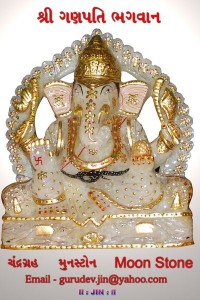

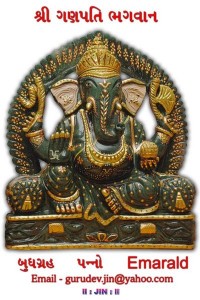
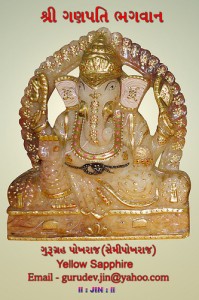
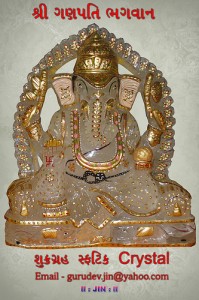
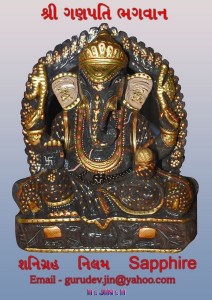
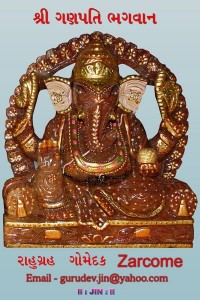
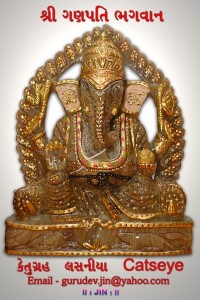
![Basohli miniature, circa 1730. National Museum, New Delhi, India.[1]](http://upload.wikimedia.org/wikipedia/commons/thumb/6/64/Ganesha_Basohli_miniature_circa_1730_Dubost_p73.jpg/275px-Ganesha_Basohli_miniature_circa_1730_Dubost_p73.jpg)

